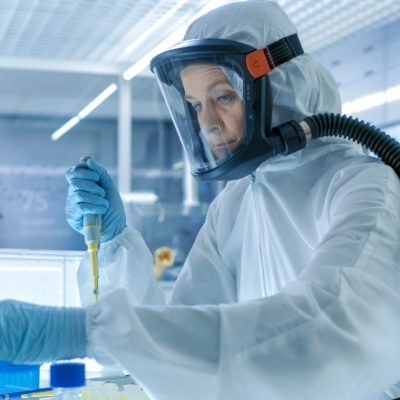What Are Biological Safety Levels?
BSLs are sets of biocontainment precautions required to isolate potentially hazardous biological microorganisms in enclosed, controlled environments. They’re intended to ensure operator safety by outlining recommendations for safe operating procedures and atmospheric controls. BSL protocols are used everyday in a number of industries and applications, from medical, to microbiology, to environmental testing.
The Four Biological Safety Levels
The CDC has proposed four BSLs, each of which is associated with a varying degree of danger, and a set of appropriate operational protocols. These levels range from Biosafety Level 1 (least hazardous) to Biosafety Level 4 (most hazardous). Below, we’ll explain the basics of BSL 1, 2, 3, and 4.
BSL-1
BSL-1 requires a basic level of protection against agents that aren’t known to cause disease in healthy, non-immunocompromised humans. This could include non-pathogenic and non-infectious bacteria like E.coli. Usually, there are doors that separate a BSL-1 lab from the rest of the facility, but within those doors, operators can do open-bench work with just the most standard regulations in place: personal protective equipment (PPE), hand washing, and decontamination of work surfaces after use.
BSL-2
BSL-2 requires a level of protection appropriate for handling moderate-risk agents, known to cause varying degrees of disease in humans. This could include the microbial organisms like Staphylococcus aureus or Salmonella. A BSL-2 cleanroom is restricted from the rest of the facility behind self-closing doors, and features various biological safety cabinets (BSCs) to perform procedures safely in. Operators are required to wear additional PPE, including a face shield, and follow each of the standard cleanliness regulations as in BSL-1.
BSL-3
BSL-3 requires protection against “exotic” airborne microbial agents that are known to sometimes cause fatal reactions in humans post-ingestion. An example of one of these agents is Mycobacterium tuberculosis. Because of the potentially deadly nature of these microbes, BSL-3 cleanrooms require even more enhanced protection protocols, including:
- The lab must be restricted behind two sets of doors.
- Operators must be immunized and wear PPE, plus respirators.
- All work must be performed in a BSC.
- Filtered room air must be exhausted appropriately.
BSL-4
BSL-4 requires the maximum amount of preventative measures and protection. It’s recommended in labs that handle agents that have a high risk of airborne transmission and are frequently fatal for humans. Often, this includes microbial agents that we don’t yet have a treatment for, such as Ebolavirus. BSL-4 necessitates that operator and environmental protection is at its highest level, meaning the following protocols are in place:
- The lab is located in a completely separate building.
- Operators must wear PPE, including a full-body, positive-pressure cleanroom suit.
- Operators must shower after exiting the lab.
- All work must be performed in a Class III BSC.
- All material must be decontaminated before exiting the lab.
Biological Safety Levels vs. ISO Classifications: What’s the Difference?
While BSLs and ISO classifications are both withheld in cleanroom environments, there isn’t much correlation between them because they deal with different issues: protection of operators from biological exposure vs. protection of sensitive product materials from contaminant exposure. That being said, BSLs work in tandem with ISO classifications, with most requiring ISO Class 7 cleanrooms with separate gowning and degowning rooms. It’s best to have a conversation with your cleanroom manufacturer to get a sense of how to accommodate both needs and keep your operators, products, and environment safe all at once. Maintaining a controlled, biosafe environment is critical for many environmental and medical cleanroom applications. If you need a cleanroom that’s designed to meet specific design or cleanliness requirements, contact Angstrom Technology. Our team of experts is happy to help you build the solution you’re looking for.



